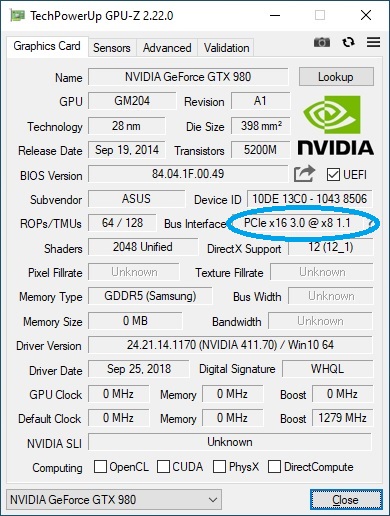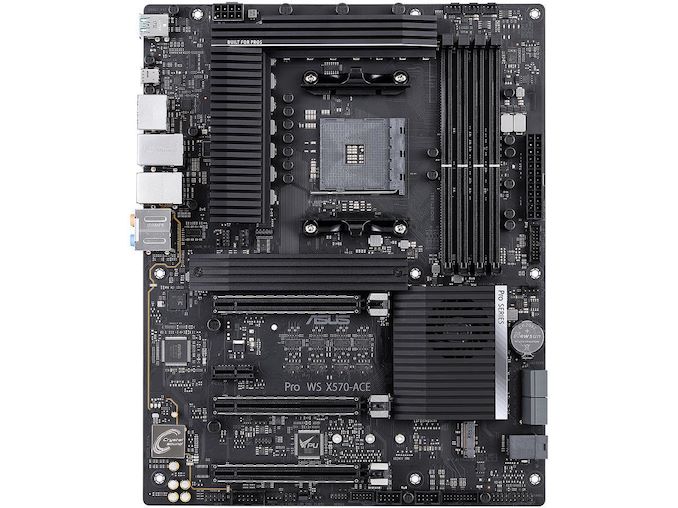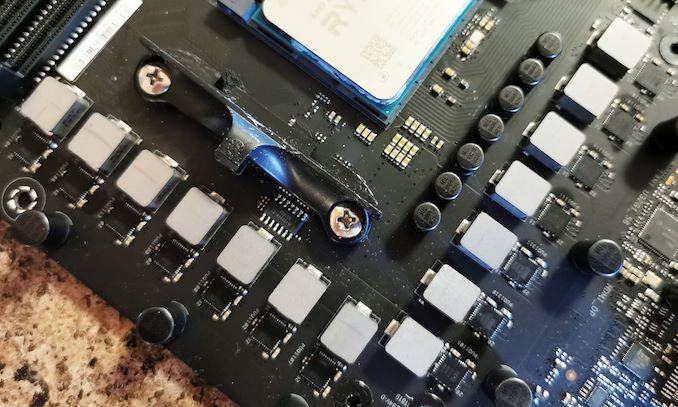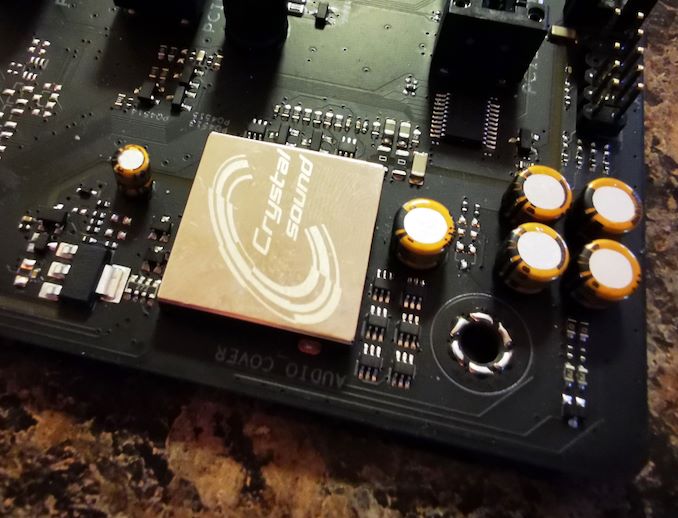The ASUS Pro WS X570-Ace Review: x8x8x8 with No RGB
by Gavin Bonshor on August 12, 2019 9:00 AM ESTVisual Inspection
Setting its sights on professional and workstation users, the ASUS Pro WS X570-Ace encompasses a strict and elegant design without the plethora of RGB LEDs that plenty of other models do. Instead, the Pro WS X570-Ace uses straight angled black aluminium heatsinks with the fins aligned horizontally on an all-black PCB. This includes the power delivery heatsink, the actively cooled X570 chipset heatsink, and the single PCIe 4.0 x4 M.2 heatsink. Located around the edge of the board are six 4-pin headers which support one CPU fan, one AIO pump connector, and four chassis fans. At the bottom of the PCB is an ASUS NODE connector hardware interface controller. While there aren't many products out which support this, InWin is currently developing an OLED screen which can display statistics such as CPU temperature, and fan speeds.
In the top right-hand corner of the board is four memory slots with support for DDR4-4400 memory, and is capable of housing up to 128 GB of system memory. A lot of vendors mention support for ECC memory in its specifications, but the ASUS Pro WS X570-Ace has validated support for ECC memory (and non-ECC). This means users can build an X570 based workstation with all the benefits of ECC memory including options in the firmware for memory scrubbing and memory addressing; this ultimately comes down to processor support including the AMD Ryzen Pro models. The WS X570-Ace also benefits from ASUS's OptiMem which is essentially a method of making the memory trace layout more efficient and can help to reduce memory latencies when overclocking, as well as potentially increase memory frequency yield too.

The bottom full-length PCIe 4.0 slot on the Pro WS X570-Ace operates at x8
One of the main features that sets this model apart from the rest of the current X570 product stack is in its PCIe 4.0 support. The ASUS Pro WS X570-Ace has three full-length PCIe 4.0 slots which operate at x16, and x8/x8, and the bottom slot operates at x8 powered through the chipset. All three full-length slots include a coating of metal armor re-inforcement, and for users looking to use a dedicated soundcard or another networking card, ASUS also includes a single PCIe 4.0 x1 slot.
Although the ASUS Pro WS X570-Ace is more geared towards workstation users, its power delivery is more than suitable for enthusiasts looking to overclock Ryzen 3000 processors too. It has a 12+2 phase design that is controlled by an ASP1405I running at 6+1 which is a custom variation of an International Rectifier IR35201 PWM controller. ASUS has opted to use teaming as opposed to doubling up phases for better transient response across its X570 models. As a result of this, the CPU VCore section is running 12 x IR3555 60 A power stages and the SoC is using 2 x IR3555 60 A power stages which are teamed together in pairs to create the 6+1 design. Delivering power to the processor is a single 8-pin 12 V ATX CPU power input.
Moving onto the storage capabilities of the ASUS WS Pro X570-Ace, we have two PCIe 4.0 M.2 slots with the top M.2 slot allowing for both PCIe 4.0 x4 and SATA drives to be used which includes an M.2 heatsink. The M.2 slot located at the bottom of the board only has support for PCIe 4.0 x2 drives, although this model does include a U.2 PCIe 3.0 x4 slot, and four SATA ports with support for RAID 0, 1, and 10 arrays.
The ASUS Pro WS X570-Ace uses a Realtek ALC1200S HD audio codec which provides five 3.5 mm audio jacks, and an S/PDIF optical output. On the Realtek ALC1200S HD audio codec is an EMI shield and is supported with six gold Japanese audio capacitors. The audio PCB is also separated from the rest of the board's componentry.
On the rear panel are two Ethernet ports, one being Realtek RTL8117 and the other an Intel I211-AT. ASUS has included four USB 3.1 G2 Type-A, one USB 3.1 G2 Type-C, and two USB 3.1 G1 Type-A ports, as well as a pair of video outputs including an HDMI 1.4b, and DisplayPort 1.2. Touching on the Realtek RTL8117 Gigabit NIC, this is supported by the ASUS Control Center Express which is a server-focused application which also doubles up as a management controller. It allows for out-of-band management and hardware-level control.
What's in the Box
Included in the box is a very fundamental accessories bundle which includes four SATA cables, an M.2 screw package, a driver and software installation disc, an I/O shield, and a user manual. The most noteworthy accessory in the bundle is an ASUS VGA holder designed to eliminate sagging in heavyset graphics cards, which can not only damage the card but the PCIe slot too if it isn't secured properly.
- 4 x SATA cables
- Rear I/O shield
- 1 x ASUS VGA holder
- 1 x M.2 screw package
- 1 x Installation disk
- User manual















110 Comments
View All Comments
umano - Wednesday, August 14, 2019 - link
It seems a great mb and it has a wonderful look. It is not the board for me, I'd go HEDT with an Atx board, but I like the approach based on quality, caring about details that do not shine on paper or on images but they shine on performance, reliability and why not pleasure to use. The shield and separation for the audio it is a needed touch of design elegance.I really hope this is not the last we heard from x570 boards, to me the x570 offer lacks an outstanding pro oriented Itx board.
FredeBR - Wednesday, August 14, 2019 - link
I saw comments that 3900x works very hot (high temperature). On this asus board is it possible to configure processor downclock, like lowering the cpu voltage? I will use for full load processing for more than 24 hours in a row.TheinsanegamerN - Thursday, August 22, 2019 - link
The 3900x is a 12 core CPU. It's goona need some big boy cooling. If you dont want to deal with the heat you should probably stick with an 8 core ryzen. You could turn off turbo boost, but then why bother shelling out more for the big chips if youre just gonna kneecap it?abufrejoval - Thursday, August 15, 2019 - link
As much as I like the 3x8 general option, it pains me that the first logical addition to a GPU and perhaps a RAID controller, 10GBase-T Ethernet is going to swallow 8 lanes of PCIe 4, while a single lane would be quite sufficient and actually the Ethernet IP block for that is already supposed to be inside the 'chipset'! And that price, whatever licence cost required to make use of it, should be included.Otherwise it looks like one of the sanest mainboard designs I have seen so far.
alpha754293 - Thursday, August 15, 2019 - link
"One of the key elements to this board design is the x8/x8/x8 PCIe 4.0 slot layout. This motherboard is the only one on the market that uses a full PCIe 4.0 x8 lane available from the AMD X570 chipset, enabling an array of different use cases that ASUS believes this market needs. Technically the upstream link to the CPU is still limited to PCIe 4.0 x4, however this does enable PCIe 3.0 x8 cards to have full bandwidth, which accounts for a lot of add in cards (RAID, high-end networking)."This is quite possibly one of the worst boards on the market then.
They have three PCIe 4.0 x16 physical slots, but either only run at its native x16 speeds if you only have one card installed, x8 if you have two, and really x8/x8/**x4** if you have three cards installed since the chipset to CPU interface is a PCIe 4.0 **x4** link.
That is so dumb.
Why would they bother putting in a x16 physical slot, and then because of the chipset link, only run it at x4 electrically?
Quite possibly one of the worst product development/engineering decisions ever.
A single NVMe PCIe 4.0 x4 SSD would be able to consume all of that bandwidth.
moriz - Friday, August 16, 2019 - link
i think the key here is that the third slot can *supposedly run at PCIe **3.0** x8, which allows it to give full bandwidth to any PCIe 3.0 x8 add-in card.*supposedly, because i've yet to see any confirmation that it is capable of doing the PCIe version switch.
YaroslavZ - Sunday, August 18, 2019 - link
hey! , I bought this mobo a couple of days ago, I bought it because I wanted to upgrade my old cpu to R9 3900X, I also happened to have 4 R9 390 gpus (2 390s 2 390x) , sadly I don't have the cpu yet, I do have the r5 1400 lying around but I don't feel like taking it out from completely different cpu and adding it into that costly mobo just to test things out,I bought that mobo exactly to run 4way CFX with these gpus, 8x 8x 4+4x* & 4x from m.2 to pcie adapter,
based on your words, in theory the 3rd slot should be able to use more bandwidth than a simple 4x 3.0 , is that correct? if so then that will pretty good upgrade over a simple 4x.
anyways just to give you some info, a simple 4x 3.0 uses around 70~75% power of R9 390, while 8x around 99% ,
I do know that because atm i'm sitting through 8x 8x 4x in asus z170-a , which also have m.2 at x4 so 4way is possible as well but I bought the adapter just recently and I don't really want to sit through sata ssd, as well as this mobo currently have problems with 2 ram slots because of which I can't use dual channel atm, which obviously makes 3gpus to barely outperform a single gpu so adding 4th on top of that is pointless, wish the prices on r9 3900x will fall soon.
here is stock 3way (8x 8x 4x) 3dmark (firestrike ultra) score in dual channel when I still had it, also, R9 390X performing with stream processors of R9 390's if I got it right(aka it's like 3x of R9 390 even when some of them have X's), because I was forced to use R9 390 as gpu1 to enable CFX,, https://www.3dmark.com/fs/18192586
tristank - Tuesday, August 20, 2019 - link
How does this even works? Is there some kind of translation between PCIe 4.0 x4 to PCIe 3.0 x8. I dont get it. I thought this was not possible.JKJK - Friday, August 16, 2019 - link
A card like this without 10GbE is completely idiotic.You shouldn't have to waste a pci-e port on it. And it should be intel. Let the gamers use the unstable Aquantica shit chips and drivers (been there, done that).
Tomyknee - Sunday, September 1, 2019 - link
All I hear about is the chipset fan. I have read (Buildazoid in May 2019 Gig Master review) that it is the RAID setups going through the Chipset that sets the fan off. Unfortunately the second M.2 is only PCIe x2. Other than SATA drives maxed at 6gbs, it does not make sense to run RAIDO for speed. Samsung will have PCIe 4.0 NVMe M.2 that surpase 7gbs R/W within a year and the 2x will not take advantage of that.A deal breaker for me, (I really like this board, really want to order it - looks great and no RGB!)